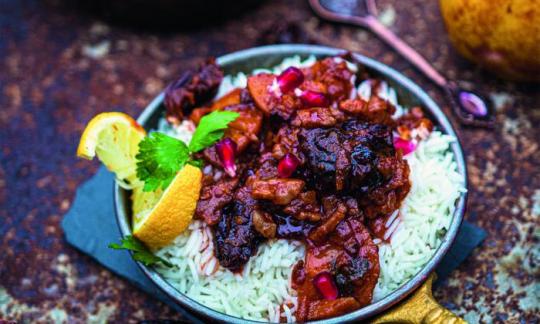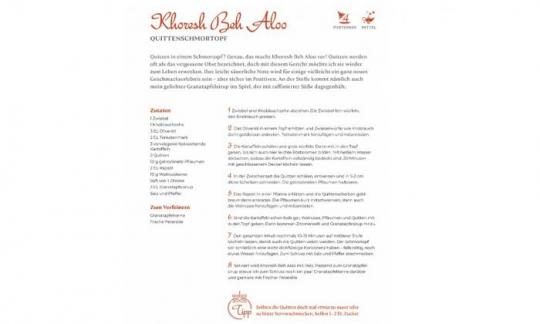Quince stew with potatoes and dried plums
vegan
Ingredients (for servings, )
| 1 | Onions, raw (organic?) (3.9 oz) |
| 1 clove | Garlic (organic?) (0.11 oz) |
| 3 tbsp | Olive oil (cold pressed, raw?, organic?) (1.4 oz) |
| 2 tbsp | Tomato paste, unsalted (organic?, raw?) (1.1 oz) |
| 3 | Potatoes, raw (organic?) (9.5 oz) |
| 2 | Quinces, raw (honey apples) (6.5 oz) |
| ⅓ oz | Plums, dried, uncooked, raw? (organic?) |
| 2 tbsp | Rapeseed oil, refined (organic?) (0.98 oz) |
| ⅓ oz | Walnuts (tree nuts), raw (organic?) |
| 1 | Lemons, raw (limes, organic?) (2.0 oz) |
| 3 tbsp | Pomegranate syrup (organic?) (1.6 oz) |
| 1 dash | Table salt (table salt, raw?, organic?) (0.01 oz) |
| 1 dash | Black pepper (organic?, raw?) (0.00 oz) |
| topping | |
|---|---|
| ¼ | Pomegranate (grenadine, raw, organic?) (2.5 oz) |
| 1 sprigs | Parsley, fresh, raw (leaf parsley, parsley) (0.04 oz) |
Equipment
- vegetable peeler
- garlic press
- skillet (frying pan)
- stove
- citrus juicer (lemon squeezer)
- saucepan
Type of preparation
- cook
- chop or grind
- squeeze
- sweat
- dry roast
- season to taste
- deglaze
- remove the skin
- peel
Preparation
Preparation of the quince stew
Peel the onion and garlic clove. Finely dice the onion and press the garlic.Heat the olive oil in a pan and sauté the onion and garlic until golden brown. Add the tomato paste and fry.
Peel the potatoes and dice them roughly. Then add them to the pot until they develop a light roasting aroma. Deglaze with hot water so that the potatoes are completely covered.
Simmer with the lid closed for 30 minutes.In the meantime, peel the quinces, remove the seeds and cut into 1-2 cm thick slices. Halve the dried plums.
Squeeze the lemon and set the juice aside.Heat the rapeseed oil in a pan and fry the quince slices until golden brown. Briefly stir in the plums, then add the walnuts and fry them too.
When the potatoes are half cooked, add the walnuts, plums and quinces to the pot. Then add the lemon juice and pomegranate syrup.
Let the entire contents simmer for another 10-15 minutes on a medium heat so that the quinces are also soft. The casserole should finally have a slightly thick consistency - add a little more water if necessary. Finally, season with salt and pepper.
Adjust the sweetness: Depending on the sweetness of the quinces, the dish will be sweeter or more sour. Adjust it to your liking using pomegranate syrup or lemon juice. Some quinces are also slightly bitter; a little sugar or pomegranate syrup can help with this.
Arrange and serve
Quince stew (also known as Khoresh Beh Aloo) is served with rice.Serayi Degerli: To match the pomegranate syrup, I sprinkle a few pomegranate seeds on top and garnish with fresh parsley.
|
Nutritional Information per person
Convert per 100g
|
2000 kcal | |
|---|---|---|
| Energy | 304 kcal | 15.2% |
| Fat/Lipids | 19 g | 27.6% |
| Saturated Fats | 2.2 g | 10.8% |
| Carbohydrates (inc.dietary fiber) | 33 g | 12.2% |
| Sugars | 9.3 g | 10.3% |
| Fiber | 5.0 g | 19.9% |
| Protein/Albumin | 3.3 g | 6.7% |
| Cooking Salt (Na:52.2 mg) | 133 mg | 5.5% |
| Essential micronutrients with the highest proportions | per person | 2000 kcal | |
|---|---|---|---|
| Vit | Vitamin C (ascorbic acid) | 35 mg | 44.0% |
| Fat | Alpha-Linolenic acid; ALA; 18:3 omega-3 | 0.81 g | 41.0% |
| Fat | Linoleic acid; LA; 18:2 omega-6 | 3.3 g | 33.0% |
| Elem | Potassium, K | 618 mg | 31.0% |
| Min | Copper, Cu | 0.27 mg | 27.0% |
| Vit | Vitamin B6 (pyridoxine) | 0.33 mg | 24.0% |
| Vit | Vitamin K | 16 µg | 21.0% |
| Vit | Vitamin E, as a-TEs | 2.0 mg | 17.0% |
| Vit | Folate, as the active form of folic acid (née vitamin B9 and | 33 µg | 16.0% |
| Min | Manganese, Mn | 0.31 mg | 15.0% |
Detailed Nutritional Information per Person for this Recipe
The majority of the nutritional information comes from the USDA (US Department of Agriculture). This means that the information for natural products is often incomplete or only given within broader categories, whereas in most cases products made from these have more complete information displayed.
If we take flaxseed, for example, the important essential amino acid ALA (omega-3) is only included in an overarching category whereas for flaxseed oil ALA is listed specifically. In time, we will be able to change this, but it will require a lot of work. An “i” appears behind ingredients that have been adjusted and an explanation appears when you hover over this symbol.
For Erb Muesli, the original calculations resulted in 48 % of the daily requirement of ALA — but with the correction, we see that the muesli actually covers >100 % of the necessary recommendation for the omega-3 fatty acid ALA. Our goal is to eventually be able to compare the nutritional value of our recipes with those that are used in conventional western lifestyles.
| Essential fatty acids | per person | 2000 kcal |
|---|---|---|
| Alpha-Linolenic acid; ALA; 18:3 omega-3 | 0.81 g | 41.0% |
| Linoleic acid; LA; 18:2 omega-6 | 3.3 g | 33.0% |
| Essential amino acids | per person | 2000 kcal |
|---|---|---|
| Tryptophan (Trp, W) | 0.03 g | 10.0% |
| Threonine (Thr, T) | 0.08 g | 8.0% |
| Valine (Val, V) | 0.10 g | 7.0% |
| Isoleucine (Ile, I) | 0.07 g | 6.0% |
| Lysine (Lys, K) | 0.11 g | 6.0% |
| Phenylalanine (Phe, F) | 0.09 g | 6.0% |
| Leucine (Leu, L) | 0.12 g | 5.0% |
| Methionine (Met, M) | 0.03 g | 3.0% |
| Vitamins | per person | 2000 kcal |
|---|---|---|
| Vitamin C (ascorbic acid) | 35 mg | 44.0% |
| Vitamin B6 (pyridoxine) | 0.33 mg | 24.0% |
| Vitamin K | 16 µg | 21.0% |
| Vitamin E, as a-TEs | 2.0 mg | 17.0% |
| Folate, as the active form of folic acid (née vitamin B9 and | 33 µg | 16.0% |
| Thiamine (vitamin B1) | 0.12 mg | 11.0% |
| Niacin (née vitamin B3) | 1.3 mg | 8.0% |
| Pantothenic acid (vitamin B5) | 0.44 mg | 7.0% |
| Riboflavin (vitamin B2) | 0.08 mg | 6.0% |
| Biotin (ex vitamin B7, H) | 2.9 µg | 6.0% |
| Vitamin A, as RAE | 9.2 µg | 1.0% |
| Essential macroelements (macronutrients) | per person | 2000 kcal |
|---|---|---|
| Potassium, K | 618 mg | 31.0% |
| Phosphorus, P | 85 mg | 12.0% |
| Magnesium, Mg | 35 mg | 9.0% |
| Sodium, Na | 52 mg | 7.0% |
| Calcium, Ca | 34 mg | 4.0% |
| Essential trace elements (micronutrients) | per person | 2000 kcal |
|---|---|---|
| Copper, Cu | 0.27 mg | 27.0% |
| Manganese, Mn | 0.31 mg | 15.0% |
| Iron, Fe | 1.5 mg | 11.0% |
| Zinc, Zn | 0.52 mg | 5.0% |
| Selenium, Se | 1.5 µg | 3.0% |
| Iod, I (Jod, J) | 3.3 µg | 2.0% |
| Fluorine, F | 0.79 µg | < 0.1% |
The slightly sour note of the quinces in the quince stew with potatoes and dried plums creates a special taste experience.
Nutrient profile: According to GDA guidelines, one portion of this recipe covers more than a third of the average daily requirement of vitamin C, potassium, copper and alpha-linolenic acid, which belongs to the group of omega-3 fatty acids. The ratio of omega-6 to omega-3 fatty acids is 4:1, which is below the maximum recommended ratio of 5:1. More on this under: Vegans often eat unhealthily. Avoidable nutritional errors.
Quinces: The quinces that grow in Switzerland, Germany and Austria are hard and taste bitter because of the tannins they contain. Therefore, varieties from more southern countries (eg Turkey) are usually used for raw consumption. The quince juice becomes sweeter when heated. The fruit only gets its fine aroma when cooked, boiled or baked.
Walnuts: In Central Europe, the common walnut ( Juglans regia) is particularly important. Of all known nuts, the walnut has the highest proportion of alpha-linolenic acid (ALA). It also has health benefits thanks to its high levels of tocopherols (forms of vitamin E) and many macro and trace elements.
Pomegranate syrup: Pomegranate syrup is an alcohol-free, sugar-sweetened fruit syrup with an intense red color. When buying, make sure that the product is really pomegranate syrup.
Processing the quince: The quince's fruit skin is covered with a fine down that contains bitter substances. To prevent this from getting into the final product, it is necessary to rub off the down with a dry cloth and wash the fruit. If you use a brush (e.g. made of brass) to rub it off, you should process the fruit immediately afterwards, as this will damage the outer skin.
Adjust the sweetness: Depending on the sweetness of the quinces, the dish will be sweeter or more sour. Adjust it to your liking using pomegranate syrup or lemon juice. Some quinces are also slightly bitter; a little sugar or pomegranate syrup can help with this.
Homemade pomegranate syrup: You can make your own pomegranate syrup in just a few steps and in under an hour, 100% free of artificial preservatives - and adjust it to the sweetness you want. All you need is 6 pomegranates and a little sugar to make about 250-300 ml of juice. You can find the recipe at the following link: Classic pomegranate syrup with granulated sugar





